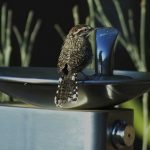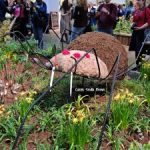Don’t worry, we are not going to suddenly wade into the murky and scary world of the politics of healthcare reform, and we are not going to debate this concept here, but this debate gives us some wonderful language from which to illustrate the concepts of Ecosystem Gardening and how your actions can really make a difference. I’ve put together a list of terms being endlessly bandied about in this debate and made an analogy of how you can apply them to the choices for wildlife you make in your garden.
The Uninsured
Wildlife species of all kinds are in serious trouble because of habitat loss, fragmentation, and degradation due to human action. We are simply leaving them no place to go. Without action from us many species will disappear. “Uninsured” species (those most at risk) include birds, butterflies, frogs, toads, salamanders, bats, and native pollinators. We have the ability to provide for the “uninsured” wildlife species by making positive choices in our gardens and creating welcoming habitats for them. Even small choices can have a great impact, such as planting native plant in that empty spot, providing host plants for butterfly caterpillars, adding a water source, or creating a nectar garden for native pollinators and butterflies. Doug Tallamy, author of Bringing Nature Home, talks of these choices when he states:
Now, for the first time in its history, gardening has taken on a role that transcends the needs of the gardener. Like it or not, gardeners have become important players in the management of our nation’s wildlife. It is now within the power of individual gardeners to do something that we all dream of doing: to “make a difference.” In this case, the “difference” will be to the future of biodiversity, to the native plants and animals of North America and the ecosystems that sustain them.
Pre-existing Conditions
We have developed a set of “pre-exisiting conditions” that threaten wildlife. As human development has spread from the cities to the suburbs and beyond and gobbled up farmland, drained wetlands, clearcut forests, and made room for the necessities of life such as another Walmart, strip mall, luxury condo, or business park, we have taken away vital habitat for wildlife, degraded ecosystem function and services, and left many species of wildlife and plants in danger of extinction.
Big Pharma
We have been seduced by the $32 billion dollar per year chemical fertilizer, herbicide, and pesticide industry who spends millions of dollars each year convincing us that we are less than perfect citizens if we do not continue to purchase and apply these poisonous elixirs. In fact, this industry is currently spending millions of dollars to convince us that Michelle Obama has placed her children in great danger because she has not succumbed to the “Big Pharma” hype that food safety can only be insured by the application of their magic potions, but she has instead opted for an organic vegetable garden at the White House (Yay, Michelle). We must say no to “Big Pharma.” Pesticides have wiped out large numbers of butterflies and native pollinators. Herbicides have destroyed endangered native plants and may be a cause in the decline of frogs and toads. And fertilizer runoff causes a dead zone larger than New Jersey every year at the mouth of the Mississippi in the Gulf of Mexico where fish, shrimp, crabs and other life are unable to survive (and neither are the fishermen who are dependent on this harvest for their livelihoods).
The Public Option
Enter the Public Option. We have seen that habitat loss, fragmentation, and degradation due to human activity are the primary reasons for the decline of so many species. If our activities can be harmful, they can also be helpful if we so choose. I have been saying for years that if every one of us did just one thing to benefit wildlife on our properties, the results could be amazing. We can learn to share our lives and property with wildlife by giving back a little bit of habitat. The effect of human alteration of the land has touched every place on earth, no matter how far from human settlement they may be. Therefore, it is in our hands to make some choices that will, in part, reverse this trend. Our role as property owners is first to take a landholder version of the Hippocratic Oath: FIRST, DO NO HARM. This is the public option. Each of us has a duty to become stewards of our land and learn to make healthy choices for the wildlife in our care. This duty was expressed very elegantly in Sara Stein’s great book, Noah’s Garden: Restoring the Ecology of our own Backyards
….we have left our land too retarded to take care of itself, much less to be of any help to us. This is not someone else’s problem. We–you and I and everyone who has a yard of any size–owns a big chunk of this country. Suburban development has wrought habitat destruction on a grand scale. As these tracts expand, they increasingly squeeze the remaining natural ecosystems, fragment them, and sever corridors by which plants and animals might refill the voids we have created. To reverse this process–to reconnect as many plant and animal species as we can to rebuild intelligent suburban ecosystems–requires a new kind of garden, new techniques of gardening, and, I emphasize, a new kind of gardener.
The Co-op Idea
Now that you’ve embraced the public option that we are each responsible for the management of our properties in ways that support wildlife, it’s time for the Co-op idea. Spread the word to your neighbors. When neighborhoods join together to create welcoming habitats for wildlife, much more can be accomplished. Healthy choices on your property make a difference. Better choices as a neighborhood make a bigger difference. And this spreads to your city, your state, and so on. Start a Conservation Gardening for Wildlife Co-op in your neighborhood now.
The Angry Mob
We gardeners can be a very passionate group. This is especially true in the ongoing natives vs. exotics debate. You can see this by reading “What’s Invasive: Telling People what they can’t plant in their yards” and the comments that follow. This is an Angry Mob, with neither side being willing to give an inch. Now instead of folks reacting badly to being told what they can and cannot plant it would be much kinder if we could focus on the consequences of our actions. Invasive plants are destroying wildlife habitats. Therefore, when we make the choice not to plant them we are helping to protect those habitats. It’s very simple. Take responsibility for your actions.
Single Payer
We as taxpayers are the “Single Payer.” We pay billions of dollars each year to attempt to eradicate or control invasive species and restore ecosystem function and services. It is much cheaper to protect ecosystem services than it is to attempt to restore them. If we became educated and informed gardeners, we would not continue to import and promote the spread of invasive plants. Please obtain a list of invasive plants for your state. Print it out and carry it with you every time you go to your local nursery. Do not purchase any plant on that list. This is very important, and we must each learn to be responsible Conservation Gardeners.
More From Ecosystem Gardening:
Submit your review | |








